The marketing of the future
The incorrect assumption is that traditional and Internet marketing are entirely different things that need entirely separate approaches
Don't divide traditional and online marketing
In large corporations and similar companies that have been in existence for decades, digital marketing is often added as a second parallel structure alongside the historical marketing activities. The incorrect assumption is that traditional and Internet marketing are entirely different things that need entirely separate approaches. My basic example:
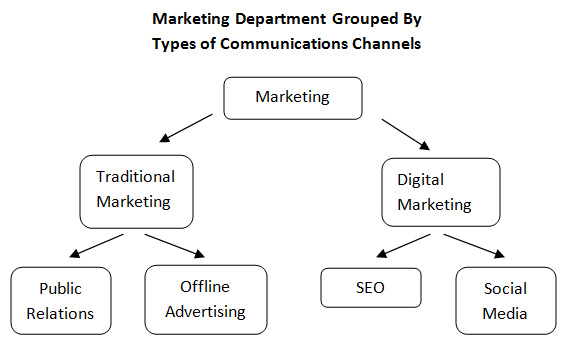
But such a structure can lead to major problems.
At a prior agency, we had a client who hired us for both public relations and organic social media (in addition to paid social-media advertising and conversion-rate optimization). The goal of the PR team was to get coverage of the business and its executives in major, relevant publications. The goals of the Social Media team were to generate qualified sales leads and build a large Twitter following.
However, due to the flawed decision to separate PR and social media, the extremely-large number of good Twitter followers did not come despite the company's gaining of major coverage from outlets including Fox News, The New York Times, Forbes, Wired, and AdWeek.
Why? The PR team did not concern itself with social media, and the Social Media team did not think about public relations. There were many missed opportunities:
- Press releases that were sent to reporters and influencers could have included the Twitter handle and links to the Twitter account
- The PR team could have asked the Fox News' segment producers to include the company's Twitter handle on the bottom part of the screen when the program showed the CEO's name and business
- PR could have advised the CEO to make sure that the company's Twitter handle was listed in the footer of presentation slides
- The company's booths at global events could have showcased the Twitter hashtag
Now, it was not the PR team's fault – I can attest that they were intelligent, professional people. It was just not how the agency's operations were structured as a whole. The PR team did not think about anything relating to social media because it was the Social Media team's responsibility – and vice versa.
Incorporate Twitter naturally into your PR and publicity activities. There are no "tricks" to gaining large followings. The key to being big on social media is to become something big in the first place. The online and offline worlds reflect each other.
Don't create too many silos
In contrast to larger companies with long, vertical, and parallel structures, many small businesses and startups today are extremely horizontal and flat. According to 7Geese, companies such as Morning Star and Return Path have even taken it to an extreme by stating that "no one has a boss."
Here is another basic example of mine of how marketing departments in companies with flat philosophies are structured. Every single function is on the same level:
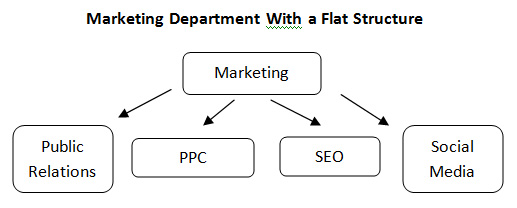
Here are a few excerpts of my conversion with the CMO:
Me: What is the function of the SEO team?
CMO: To get more links.
Me: But the PR team will get the links you need naturally.
CMO: The SEO team will buy the links that we want the most. It's just easier and faster that way.
And then:
Me: So, you've got a PR team to reach out to journalists and bloggers?
CMO: Yes.
Me: What if a writer is only reachable on Twitter – will the PR or Social Media team reach out to them?
CMO: (silence)
And then:
Me: What will the Social Media team do?
CMO: Spread the word about the company's products on social media.
Me: How will they do that by themselves without content and without essentially doing PR's job?
CMO: (silence)
How to think about marketing functions
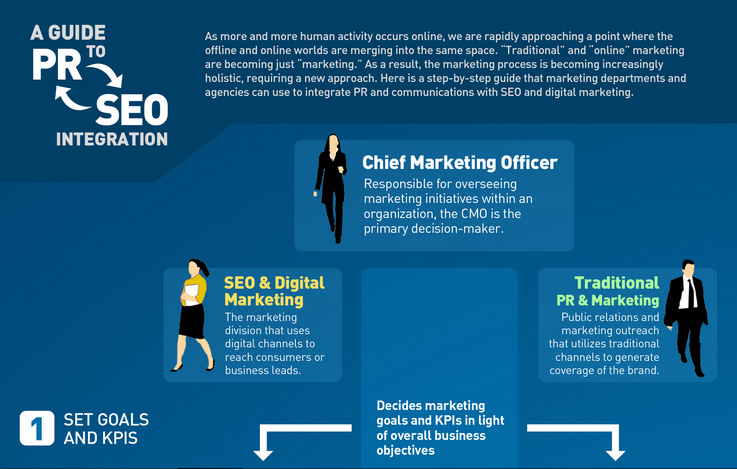
A sender decides upon a message; the message is packaged into a piece of content; the content is transmitted via a desired channel; and the channel delivers the content to the receiver. Marketing is essentially sending a message that is packaged into a piece of content to a receiver via a channel. The rest is just details.
That same theoretical idea can be applied in an actionable way in terms of how to structure a marketing department, agency, or campaign. I describe the four-fold process as such: Strategy, Creative, Communications, and Audit.
In light of this idea, I argue that the operations of a marketing department should flow along these four lines and not divide traditional and digital channels because the Internet is just a set of new communications channels that can be used to execute overall marketing functions.
Here is a new flowchart that outlines this overall process:
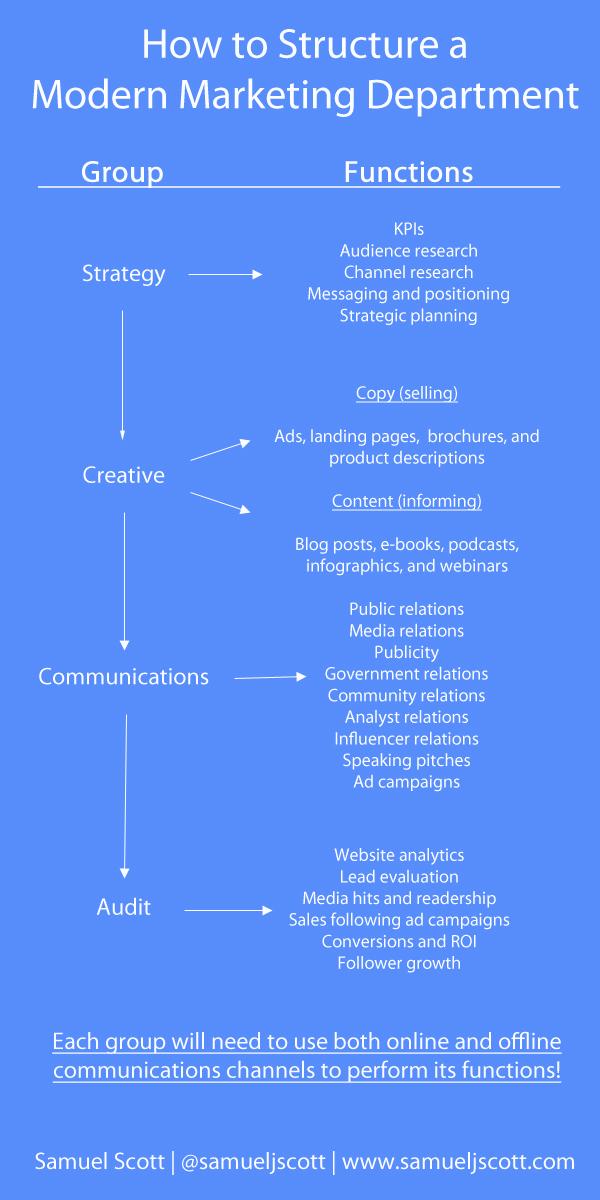
Strategy
The senior marketing executives identify the marketing KPIs (Key Performance Indicators) based on the company's overall business goals and craft a strategy accordingly. They also research the target audience and potential channels, create the overall messaging and positioning, and develop a plan of execution.
Creative
The creative team then creates all of the marketing collateral – what is now called "content" – based on the target audience, the positioning, and the channels on which the content will appear. The content can include blog posts, landing pages, online and offline advertisements, meta titles and descriptions, sales copy, catalogues, brochures, videos, e-books, podcasts, graphics, webinars, website text, and more.
Copy aims to sell – think taglines and product descriptions. Content aims to inform – think e-books that reveal the best-practices in a target audience's industry. The modern Creative department needs to use both.
Communications
The communications team then publicizes the marketing collateral via the desired channels. This can include paid and organic social media, print and online advertising, public relations and media relations, influencer outreach, and more.
There are many different types of communications functions – different businesses may need to use one, some, or all of them:
- Public relations – Managing the flow of information from an organization to the public
- Media relations – Responding to inquiries from journalists and bloggers
- Publicity – Getting news and blogger coverage of a person, product, event, business, or piece of content
- Community relations – Dealing with the local, non-governmental community (this often includes a company's owned and/or online community)
- Government relations – Serving as the go-between for the company and the government
- Analyst relations – Corresponding with the financial analysts who cover one's business or industry
- Influencer relations – Maintaining relationships with important figures in one's industry
- Conference speaking – Gaining speaking positions at relevant conferences
- Advertising campaigns – Running online and offline ad campaigns with the materials that were designed by the Creative department
Audit
Account executives research and evaluate the results based on the KPIs through methods including web analytics, conversions and ROI, coverage in media outlets, lead evaluations from the sales team, and more. The Strategy team can then review the information and revise future campaigns accordingly.
What this means for marketers
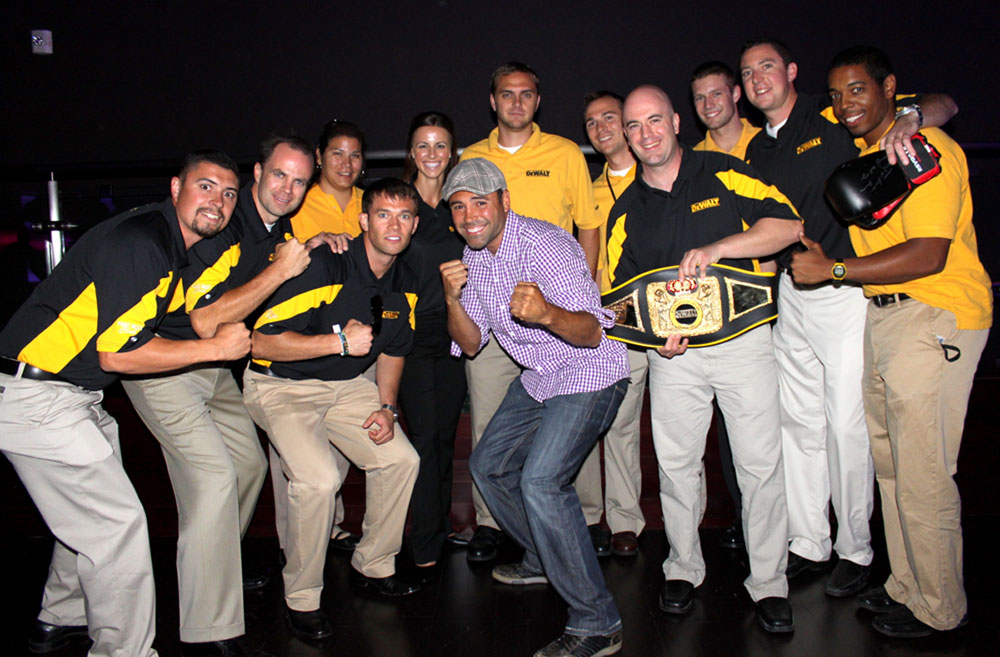
Oscar De La Hoya with the DeWalt Home Depot Marketing Team (Wikimedia Commons)
As you can see, I classify individual marketers as strategists, creatives, communicators, or auditors. Generalists as well as marketing and communications veterans tend to make good strategists. Great writers, graphic designers, and videographers are creatives. People with experience in public relations, publicity, and community relations are communicators. Analytics experts can be auditors.
But the important thing is that each "category" of people needs to learn as much as possible about executing their functions via all needed traditional and online methods. Creatives need to focus on writing, graphics, and video. Communicators need to learn how to use all communications channels – e-mail, the telephone, social media, and more. Auditors need to understand how to measure ROI and related metrics in terms of online conversions, media hits, brand awareness, and more.
Here are three examples of how individual contributors in such a traditional marketing structure will operate in the integrated marketing world of the future:
- Are you a copywriter in the Creative department? You'll also need to learn how to craft meta titles and meta descriptions that include the desired messaging and get the reader to click to the website. You'll need to write the text of website product pages while keeping semantic understanding and keyword themes in mind.
- Are you a publicist in the Communications department? You'll need to learn to use both traditional (the telephone) and online (e-mail and social media) channels to get media coverage, publicity, and brand awareness. You'll need to learn about the importance of links in general and how to evaluate the value of individual links.
- Are you in the Audit department? You'll need to use traditional PR software to find the volumes of readerships of any print, TV, or online outlet. You'll need online-mention tools to track all hits. You'll need website analytics to see how traffic from those publications performs. You'll need to learn how to allocate ROI values to multiple types of referring websites and the roles that they play throughout the marketing funnel.
To the individuals who are reading this essay, I would ask yourselves the following questions to grow your career in the coming integrated world:
- Am I a strategist, creative, communicator, or auditor? Most people want to be strategists, but few actually are.
- What else do I need to learn to become a master in my "group" area? A personal example: I have always been a writer, but I know little about graphic design. That's something I need to learn. Another example: A publicist might be great at e-mailing reporters, but he or she might not know how to engage with journalists on Twitter. Those are intra-group items to learn.
- What "group" area should I learn next? Say you're a genius at communications in general. What should you learn next – creative, auditing, or strategy? (Keep in mind that strategy is something that is best learned last after gaining experience in the other three fields.)
What this means for agencies
Historically, agencies have generally specialized in one or more of the four areas that I mentioned earlier: strategy, creative, communications and advertising, and auditing and troubleshooting. The same is true today – except that agencies will need to learn how to do those practices in both traditional and digital contexts.
However, digital marketers have had a habit of assigning new names and buzzwords to already-existing practices as if they are something new. I hate clickbait headlines that include the words "death" or "end," but I am going to make an exception here because I am very passionate about this topic and want to warn the community of the gravity of the situation.
The end of "social media marketing"
If you are an agency (or a consultant) who brands yourself as a social media expert, you need to rebrand yourself. There will be no "social media" jobs in five years. Social media is just yet another communications channel that can be used to perform existing functions as well as transmit messages and content to an audience:
- Customer-service representatives will use social media to do customer service
- Publicists will use social media to generate publicity
- Advertisers will use social media to advertise
Why is this the case? Simple. It's easier for a customer-support representative to learn how to use Twitter than for someone who knows Twitter to learn how to give great customer service.
The end of "content marketing"
The Content Marketing Institute defines "content marketing" this way (emphasis mine):
Content marketing is a strategic marketing approach focused on creating and distributing valuable, relevant, and consistent content to attract and retain a clearly-defined audience — and, ultimately, to drive profitable customer action.
In truth, "content marketing" is doing what Creative, Communications, and Advertising teams have done since time immemorial. It's nothing new. "Content marketers" also need to rebrand themselves as more and more companies and clients will begin to realize this fact. After all, one recent Nielsen study has shown that content marketing is 88% less effective than public relations – likely because most content marketers do not realize that they are really doing (in part) public relations and are therefore are not doing it well.
The end of "link building"
Over the past few years, there has been much debate over whether Google favors big brands in search results. Assuming this is the case, I would submit that the reason is merely because large companies have publicity teams that work around the clock to generate online discussions and news coverage – all of which indirectly generates millions of links.
The best link building methods are just publicity by other names. Moreover, traditional link building data such as PageRank and Domain Authority (DA) will be less and less useful as Google becomes smarter and smarter. If I sell widgets, then I want a link on a website that is read by people who like widgets – regardless of its DA. That link is more important than a link on a website that has nothing to do with widgets – even it has a vastly-higher DA.
Whenever I argue this point, traditional link builders usually respond by saying that they are needed because they are the best at ensuring that any coverage and mentions also come with links. Well, with all due respect, I respond with the statement that it's not much of a value-adding benefit. I'd just tell existing publicists to be sure that links are added to coverage whenever possible.
In economic theory, there is a principle called " opportunity cost." Basically, it states that "time spent doing A is time that is spent not doing B." In any business, there is only so much labor and time to accomplish a given task, so priorities based on ROI need to be determined. Given a time frame of three months, I'd argue that the ROI of developing and executing a publicity campaign will be far higher than spending that time fixing broken links, e-mailing countless website owners to beg for links, creating link bait, and so on.
"Link builders" will also need to rebrand themselves as more and more businesses will become wary of artificial links that may incur Google Penguin penalties. For the best results, hire PR experts instead of link builders. Links are just the by-products of good marketing and publicity.
So, what do I recommend? Stop reading articles on "how to build links." Instead, learn everything you can about public relations, communications, and publicity. Since the other sections of this essay that focus on strategy, content, and analytics typically receive a lot of attention on Moz, I'll provide a list of resources elsewhere on publicity. Here are some good places to start:
- Public Relations: Strategies and Tactics (textbook)
- This is How You Pitch (book)
- The Publicity Handbook (book)
- International Public Relations Association
- Public Relations Society of America
- Institute for Public Relations
- Best and Worst Ways to Get Publicity (Inc.)
- How to Generate Publicity for Your Business (Entrepreneur)
The end of link penalty removals
I stopped thinking about links a long time ago while I was at a prior agency job. My team and I would do the technical SEO, the creative and the publicity – and the best links would come naturally by themselves. I would not actively track links except for periodic checkups to make sure that competitors were not pointing spammy backlinks at our clients. It happens – one time, I saw a lot of link spam directed at a website with anchor text that was stuffed with keywords relating to prescription drugs. I disavowed them.
But except in that specific circumstance, I want to live in a world where link audits, link-removal software, and the Google Disavow Tool are no longer needed. For one reason, I feel bad for our collective clients. Many of us spent years making money recommending for and then building bad, artificial links – and now we're making money to remove them. But for the most part, I want to be in an industry where we no longer build links – or even specifically think about them in general.
If you do real, bona fide publicity, then you'll never, ever have to worry about Google Penguin penalties.
But, wait! Where's SEO?
Now, I did not mention search-engine optimization much until now for a reason. We're thinking about it wrongly.
Technical SEO
All technical and on-page SEO is copywriting and specialized web development. Copywriters (and sometimes content writers) should write meta titles and meta descriptions as well as website and landing-page text. The rest just comes down to web developers focusing on items ranging from XML sitemaps to mobile-responsive design to schema code.
Think about it from a financial perspective: It's far cheaper and more efficient to hire a web developer who knows to include all of these functions rather than to hire both a web developer and an SEO.
Off-page SEO
As I described earlier in my discussion of linkbuilding, the best off-page SEO is really just public relations and publicity and should be done by a communications team rather than an SEO.
Essentially, "SEO" is a collection of best practices that can and should sit in already-existing marketing and web-development teams. As much as this thought may prove to be controversial, SEO functions should be dispersed among other jobs. Most of the time, there is little need for separate and individual "SEO" agencies, functions, and employees.
Same as it ever was

The Talking Heads in 1978 (Wikimedia Commons)
Strategy. Creative. Communications. Audit.
If you do this process well and do it continuously to build a strong brand over time, then everything else will take care of itself. Higher search-engine rankings. More traffic. More customers. More leads. More sales. More brand awareness. And in the end, greater revenue and profit.
There are no shortcuts – it's just doing good marketing both online and offline together.
When you create a marketing department or team today, it's crucial to keep this in mind – in fact, it's what marketers have always kept in mind and the process that they have always followed. Same as it ever was. The traditional marketing practices of yesteryear are still relevant today. The only difference is that we are operating in an increasing number of available communications channels called the Internet.
Thanks to Moz.